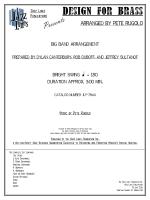DESIGN FOR BRASS [DOWNLOAD]
Recorded by Vic Lewis
Arranged by Pete Rugolo, Prepared by Dylan Canterbury, Rob DuBoff, and Jeffrey Sultanof

Cat #: JLP-7844DL
$65.00This product is available for immediate download after purchase.
Questions?
Please call +1-518-587-1102 or email us.
Edition: Jazz Big Band Arrangement
Description: Swing - Advanced
Publisher: Jazz Lines Publications
Although Vic Lewis would go on to have a highly successful career as an agent and manager for several high profile pop musicians, he first rose to prominence as one of the first British bandleaders to actively embrace and attempt to replicate the sounds of the Stan Kenton Orchestra. It should come as no surprise that Design for Brass, a piece commissioned for longtime Kenton arranger Pete Rugolo, serves as a perfect example of Lewis's musical conception in action.
The arrangement begins with a lengthy introduction that can be charitably described as bombastic. A series of disjointed ensemble clanks wrap around some occasionally more melodic ideas, such as the ascending trumpet line in measures 3-4 or the mildly sinister saxophone invention in measures 17-18. The melody proper begins at measure 29, and, as the title implies, is handled by the brass section. The trumpet ranges are extremely demanding throughout the performance, but in particular during this part, and require a strong section with multiple individuals capable of handling lead trumpet-style ranges. Make sure that your entire band doesn't get thrown off by the sudden time signature shift at measure 43, either.
Things become more soloist-oriented beginning at measure 61, starting off with a full chorus of alto saxophone. This is followed by half a chorus of trombone at measure 93, a half chorus of tenor saxophone at measure 109, and a brief four bars of scream trumpet at measure 129. Some more disjointed and angular rhythmic hits in the horns wrap around one another for eight measures at 133 before the final melody resumes. Another unexpected time shift occurs at measure 153, with an almost theatrical ascending harmonic progression that ushers in a brief recap of the introduction. Things finally come to an end with an appropriately dissonant, even hostile, final brass chord with the saxes and rhythm section playing support.
There is a 5th trumpet and tuba part that the arrangement may be performed without. This publication is not a transcription - it has been prepared from the original set of parts.
2 Alto Saxophones
2 Tenor Saxophones
Baritone Saxophone
5 Trumpets
4 Trombones
Tuba (or Bass Trombone)
Guitar (Optional)
Piano
Bass
Drums
Trumpets 2-3: E6
Trumpets 4-5: D6
Trombones 1-2: B4













